
USS Vermillion Bay (CVE-108) was an Commencement Bay-class escort carrier of the United States Navy. She was renamed Kula Gulf on 6 November 1943; laid down by Todd-Pacific Shipyards, Inc., Tacoma, Wash. on 16 December 1943; launched on 15 August 1944; sponsored by Miss Dorothy Mott; completed by Willamette Iron & Steel Corp., Portland, Oregon; and commissioned at Portland on 12 May 1945, Captain J. W. King in command.

USS Luzerne County (LST-902) was an LST-542-class tank landing ship built for the United States Navy during World War II. Named after Luzerne County, Pennsylvania, she was the only U.S. Naval vessel to bear the name.

USS Algol (AKA-54) was an Andromeda-class attack cargo ship. She was the first ship of the United States Navy by this name, after Algol, a fixed star in the constellation Perseus. Algol served as a commissioned ship for 22 years and 1 month.

USS Haskell (APA-117) was the lead ship of her class of attack transports, built for the United States Navy during World War II. She was of the VC2-S-AP5 Victory ship design type. Haskell was named for the Haskell Counties of Kansas, Oklahoma, and Texas.

USS Kittson (APA-123) was a Haskell-class attack transport in service with the United States Navy from 1944 to 1946. She was scrpped in 1973.

USS Logan (APA-196) was a Haskell-class attack transport of the United States Navy, named for counties in Colorado, Illinois, Kansas, Kentucky, Ohio, Oklahoma, Nebraska, North Dakota, and West Virginia. The Haskell-class design, United States Maritime Commission standard type VC2-S-AP5, is a sub type of the World War II Victory ship design.

USNS Harris County (T-LST-822) was an LST-542-class tank landing ship built for the United States Navy during World War II. Named for counties in Georgia and Texas, she was the only U.S. Naval vessel to bear the name.
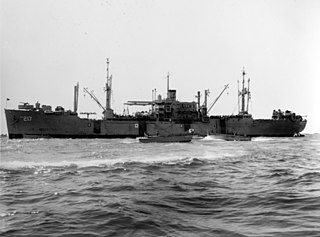
USS New Kent (APA-217) was a Haskell-class attack transport in service with the United States Navy from 1944 to 1949 and from 1951 to 1954. She was scrapped in 1972.
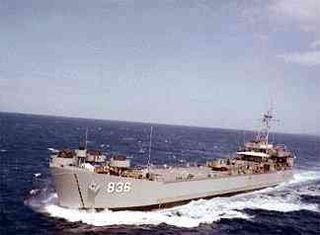
USS Holmes County (LST-836) was an LST-542-class tank landing ship built for the United States Navy during World War II. Named after counties in Florida, Mississippi, and Ohio, she was the only U.S. Naval vessel to bear the name.

USS Kishwaukee (AOG-9) was a Patapsco-class gasoline tanker acquired by the U.S. Navy for the task of transporting gasoline to warships in the fleet, and to remote Navy stations.

USS Lycoming (APA-155) was a Haskell-class attack transport in service with the United States Navy from 1944 to 1946. She was scrapped in 1973.
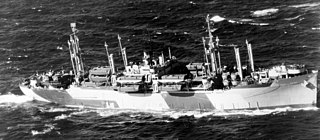
USS Lubbock (APA-197) was a Haskell-class attack transport in service with the United States Navy from 1944 to 1946. She was scrapped in 1975.
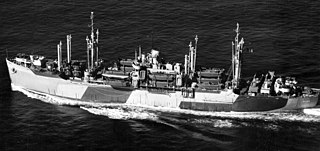
USS Magoffin (APA/LPA-199) was a Haskell-class attack transport in service with the United States Navy from 1944 to 1946 and from 1950 to 1968. She was scrapped in 1980.

USS Hampton (APA-115) was a Bayfield-class attack transport that served with the United States Navy from 1945 to 1946. She was old into commercial service in 1947 and was scrapped in 1973.

USS Henrico (APA-45) was a Bayfield-class attack transport that served with the United States Navy in World War II, and subsequently in the Korean War, Cold War and Vietnam War.

USS Telfair (APA/LPA-210) was a Haskell-class attack transport that saw service with the US Navy in World War II and the Korean War. She remained in service through most of the 1950s and 1960s, where she participated in various peacetime operations. Telfair was named for Telfair County, Georgia, which was itself named after Edward Telfair, the second Governor of the state, a member of the Continental Congress, and a signer of the Articles of Confederation.
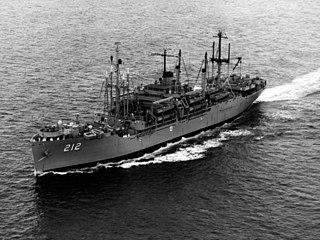
USS Montrose (APA/LPA-212) was a Haskell-class attack transport in service with the United States Navy from 1944 to 1946 and from 1950 to 1969. She was scrapped in 1970.

USS Mountrail (APA/LPA-213) was a Haskell-class attack transport of the US Navy in World War II, the Korean War and Vietnam War era. She was of the VC2-S-AP5 Victory ship design type. Mountrail was named for Mountrail County, North Dakota.

USS George Clymer (APA-27) was an Arthur Middleton-class attack transport that saw service with the US Navy in four wars - World War II, the Chinese Civil War, the Korean War and the Vietnam War. It was named after United States Founding Father George Clymer.

USS General W. A. Mann (AP-112) was a troop transport that served with the United States Navy in World War II, the Korean War and the Vietnam War.




















